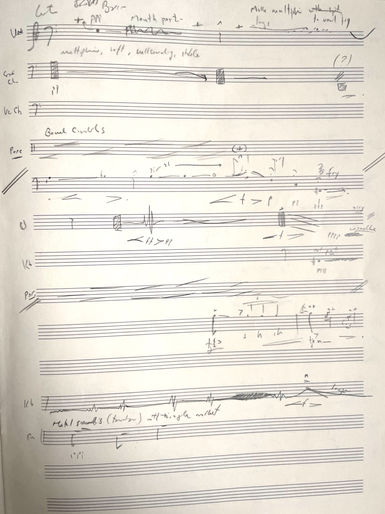BELTRAN GONZALEZ composer & conductor
carga llena, otros planes
%2013_29_53.png)
for voice, ensemble & fixed media
commissioned by Vertixe Sonora
with the support of Musikfonds e.V
premiered on 9.10.22
Santiago de Compostela, Spain
Beltrán González conductor
VERTIXE SONORA:
Enrique Martínez voice
Clara Saleiro flute
Jacobo Díaz oboe
Carlos Cordeiro clarinet
Pablo Coello sax
Carlos Cortés trumpet
Iago Ríos trombone
Helena Sousa accordion
Jacobo Hernández violin
Adya Khanna violoncello
Carlos Méndez contrabass
Diego Ventoso, Antonio Ocampo percussion
In Carga llena, otros planes (full load, other plans, I tried to build a device that immerses us in the life on board the Galician cod-fishing ships that worked on the great bank of Terranova in the eighties. "A tribute to those sailors who lived together for six or seven months in the narrowness of a ship subjected to long days of stressful work".
The notes, descriptions and memories of the five biologists from the Marine Research Institute – Enrique Álvarez, Xavier Queipo, Anxo Fernández, Eulogio Vázquez and Lorenzo Suárez – who had accompanied them on scientific research campaigns, coexist with sailors' manuals from the Xunta, ship communications Galician and audios from various sources to reconstruct the aurality of daily work during a tide: boarding, leaving the cabin, life on the bridge, work in the fishing park and dining room.
This is one of the examples of texts deployed in the piece. There are elements of a fishing vessel with description(in Spanish) taking from the Instruction manuals:
QUILLA: Pieza longitudinal que corre de proa a popa por la parte más baja y central del buque.
RODA: Pieza que en prolongación de la quilla forma el extremo del buque a proa
CODASTE: Pieza que en prolongación de la quilla forma el extremo del buque a popa
CUADERNAS: Piezas curvas que le dan forma al barco y sostienen los forros
BAOS: Piezas transversales que unen las cuadernas en la parte superior y soportan las cubiertas
BULÁRCAMAS: Son
VARENGAS: Piezas transversales que refuerzan la unión de las cuadernas a la quilla
VAGRAS: Piezas longitudinales paralelas a la quilla por las dos bandas
PALMEJARES: Refuerzos longitudinales que unen las Cuadernas entre si por los costados
PUNTALES: Piezas verticales sobre las que descansan los baos
FORRO: Es la envuelta, parte del casco, exterior a las cuadernas
MAMPAROS: Son construcciones verticales, que sirven para dividir el interior del buque.
ARRUFO: Es la deformación que sufre el casco cuando cargamos mucho peso en el centro del buque, o que el seno de dos olas se encuentran a proa y a popa.
Regarding sound, I made a trip to Vigo in order to do some field recordings on site, and also researched for more material online. I've found radio-conversations between Galician Ships, and also some field recordings made on ships fishing in Terranova. I used the description of the biologists (in the book there's one chapter devoted to sound) and their organization to classify the sound material between:
-sound from nature (the sea, the wind, the fish, the waves, etc.)
-sound from machines (engines, electric generators, motorized chains, etc.
-human made sound three big categories 1)(the work itself)2)communication 3)music
these materials generated the most part of the instrumentation, and also the fixed media tracks. The voice uses also a megaphone to create a radio-effect.
Here is a playlist with the fixed media tracks of the piece:
Here, some pictures and reviews (in spanish) of the concert:




